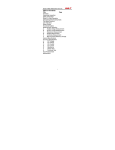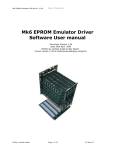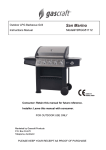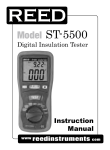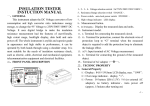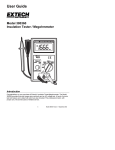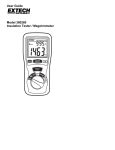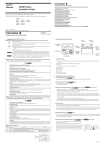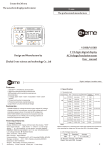Download YF-506,509 User`s Manual - Measuring instruments in Malaysia
Transcript
Thank you for your patronage. Before using this insulation meter, please carefully read the instructions below to allow proper operation, minimize damage and getting the best performance from this instrument. FEATURES 1. Measures high insulation resistance (0.1MΩ ~ 2000MΩ), manual range , of 200MΩ/250V, 200MΩ/500V and 2000MΩ/1000V. 2. Measures DC voltage (0 V~1000V), AC Voltage ( 0V ~ 750V). 3. The unit has select able long duration and momentary operation switches for high resistance measurements. 4. Equipped with a continuity test. 5. Has a DATA HOLD switch to hold LCD readings. 6. Has a Maximum Reading Hold function. -1- SPECIFICATIONS 2-1 General Specifications 1. Display: 3 1/2digit LCD that indicates values up to 1999, units, decimal point and symbols. 2. Polarity indication: Automatically displays “ - “symbol during negative input. 3. Zero adjustment: Automatic zeroing. 4. Overload indication: Display the highest “OL” at left side. 5. Low battery indication: Replace battery as LCD displays “ “. 6. Sampling rate: 2.5 times/second. 7. Power supply: 1.5V x 8 NEDA 15F IEC R6 JIS UM-3 8. Battery life: 100 hours Note: -2- Power consumption is greatest when operating in the 250V, 500V and 1,000V ranges or when measuring high insulation resistance. Battery life will be reduced if operation is frequently in these ranges. 9. Operation height:2000M under the elevation above sea level. 10. Installation categoriesⅢ 1000V. Double and Reinforce Insulation . 11. Operation environment: for indoor use , pollution degree 2. 12. Operating temperature and humidity: 0℃~ 40℃at less than 80% RHD. 13. Storage temperature and humidity:-10℃~60℃ below 70% RH. 14. Dimensions and weight: 160 x 100 x 52mm, about 480g (incl. Battery). 15. Accessories: Ohm probe -1 set, case -1 pcs), batteries- 8 PCs and operation manual. 2-2 Electrical Specifications: -3- (23℃±5℃, below 80%RH ). Accuracy:±(. . . % reading +. . . digits) DC Voltage Range Resolution DCV 1000V 1V Accuracy ±(0.5% +1) Input Impedance Overload Protection 10MΩ DC 1000V AC 750V rms AC Voltage Range Resolution ACV 750V Accuracy Input Impedance Overload Protection ± (0.8% +4) 10MΩ DC 1000V AC 750V rms 1V Insulation High-resistance Range 200M/250V 200M/500V 2000M/1000V Resolution 0.1MΩ ±)0.1MΩ 1 MΩ Accuracy ±(3%+3) Tolerance 0.4mA max 0.9mA max ±(3%+5) 1.7mA max Continuity Test Resolution Sound Indication Open Voltage Overload Protection 0. 1Ω Less than80Ω 3.3V max. -4- DC/AC 500V rms Measurement Voltage Range 250V/50MΩ Terminal Measurement Supported Range open Voltage Terminal Voltages Rated voltage ± 10% When the resistance is in the 1MΩ range, the rated voltage should reach up to 90%. 500V/1000MΩ Rated voltage ± 10% When the resistance is in the 20MΩ range, the rated voltage should reach up to 90%. 1000V/2000MΩ Rated voltage ± 10% When the resistance is in the 50MΩ range, the rated voltage should reach up to 90%. EXTERIOR FEATURES (1) Liquid crystal display (LCD): Displays measurement readings, all numerical units, symbols and range indications. (2) H.V: High voltage output indication. (3) LOCK switch: Used for extended duration MΩ measurements. (4) PUSH switch: Used for momentary duration MΩ measurements. -5- (5) D-HOLD: Holds displayed readings. (6) Function range selector switch: Meter function range selection indication. (7) V/ test socket: Positive input terminal for AC/DC voltages and continuity testing. (8) EARTH test socket: Positive input terminal for high voltage output MΩ resistance measurements. (9) Test wiring assembly. (10)MAX: Lock up max. Value of LCD. (11)LINE test socket: Negative input terminal for m Ωresistance measurements. (12)COM test socket: For connection of negative input terminal. AC/DC Voltages and continuity tests. -6- MEASUREMENT 4-1. Direct Current Voltage(DCV)andAlternating Current Voltage (ACV) measurement. 1) Select the V or V . 2) Insert the red test probe into the "V/ " socket and the black test probe into the "COM" socket. 3) Measure voltage with the two tips of the test probes (by contacting a test circuit). 4) The value of the voltage read will be displayed on the LCD screen. 4-2 Continuity Test 1) Insert the red test probe into the "V/ " socket and the black test probe into the "COM" socket. 2) Move the function switch to the " " range. 3) Place the probes in series with the circuit (a pure resistance circuit) to be tested. 4) A continuous beeps will sound when the resistance is less than 35Ω and the resistance value displayed on the LCD screen. -7- Note: (1) Continuity tests should only be conducted on a purely resistive circuit having no voltage or current present. 4-3 High Resistance Insulation Test 1) Insert the red test probe into the "LINE" socket and the black test probe into the "EARTH" socket. 2) Turn the function switch to the 200MΩ /250V,200MΩ/500V or 2000MΩ/1000V position (according to the voltage level). 3) Connect the red test probe (LINE) to center conductor of the line to be tested and connect the black test probe (EARTH) to the insulator surface. 4) Press the "PUSH" switch to allow measurement of the high voltage output. If measurement is to be conducted for an extended duration, move the "LOCK" switch from left to right to enter this testing mode. 5) The resistance reading will be displayed on the LCD screen. -8- BATTERY REPLACEMENT The meter is powered by 1.5V battery x8pcs (NEDA 15F IEC R6 JIS UM-3). use the fowling procedure to replace the battery: (1) Move the function switch to the "OFF" position. (2) Use a screw driver to unfasten the screws on the battery cover and remove the cover. (3) Take out the old batteries and replace with new batteries, taking care to note the correct polarity. (4) Re-install the battery cover and tighten the holding screws. SYMBOL/ABBREVIATION EXPLANATION 1) 2) 3) 4) 5) 6) : indicates direct current. : indicates alternating current. : indicates ground. : indicates double insulation. : indicates high voltage hazard. :Caution(refer to accompanying documents.) -9- PRECAUTIONS Extreme caution should be exercised when taking measurements under the following situations: 1. When measuring high voltages in excess of 20 volts. 2. Avoid physical contact when measuring AC power. 3. Avoid measuring voltage and current in humid or wet environments. 4. Never use meter test probes (the metal section) and other accessories that are in abnormal condition. This includes damage, bending, breakage, attachment of foreign objects and unobservable internal damage. 5. Avoid contacting exposed metal(conductive)parts, including the tested points, sockets, fasteners and wiring. 6. Always insulate yourself from circuits being measured. - 10 - 7. Never install a fuse that is of larger capacity than the unit originally used in the meter or use a replacement fuse that does not meet the recommended specifications. 8. Never operate the meter where explosive or flammable gas (or material) are present or in environments having a high dust content. IMPORTANT RECOMMENDATIONS This electrical meter is a high precision instrument. To maintain full accuracy, users must not exceed the previously described specifications regarding operation and storage. Other recommendations include: 1) Do not measure voltages that exceed DC 1000V and AC 750V rms. 2) For maintenance, use a soft dry cloth for cleaning the unit. Never use a wet cloth, solvents or water, etc. - 11 - 3) Remove the batteries if the unit will not be operated for an extended length of time. Also, do not store the unit in areas of high temperature and humidity. - 12 - GUIDE 1. FEATURES 1 2. SPECIFICATIONS 2 2-1 General Specifications 2 2-2 Electrical Specifications 4 3. EXTERIOR FEATURES 5 4. MEASUREMENT 8 4-1.DCV and ACV measurement 8 4-2 Continuity Test 8 4-3 High Resistance Insulation Test 9 5. BATTERY REPLACEMENT 10 6. SYMBOL/ABBREVIATION EXPLANATION10 7. PRECAUTIONS 11 8. IMPORTANT RECOMMENDATIONS 12 - 13 - DIGITAL INSULATION TESTER YF-509 OPERATING MANUAL - 14 -














